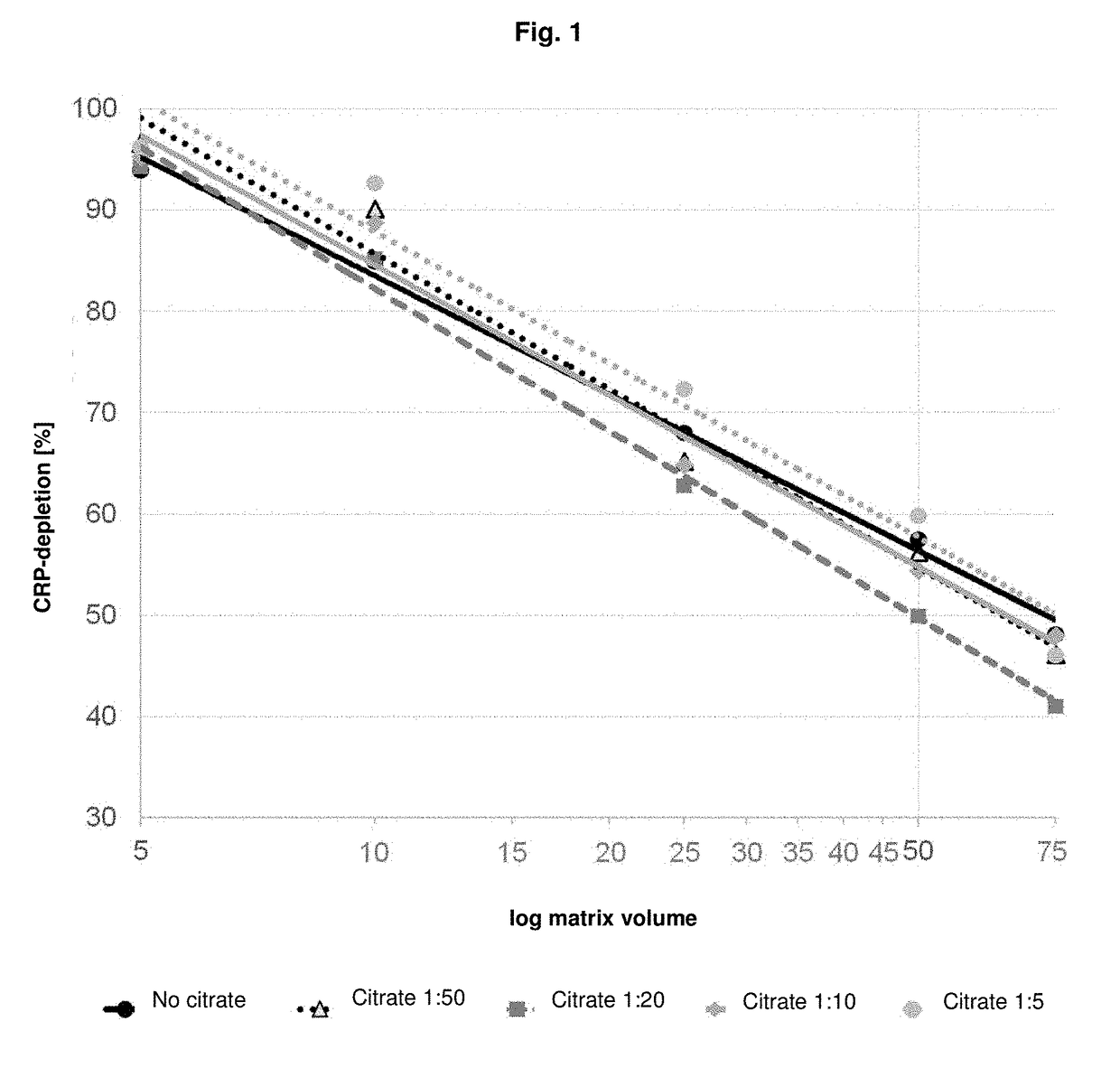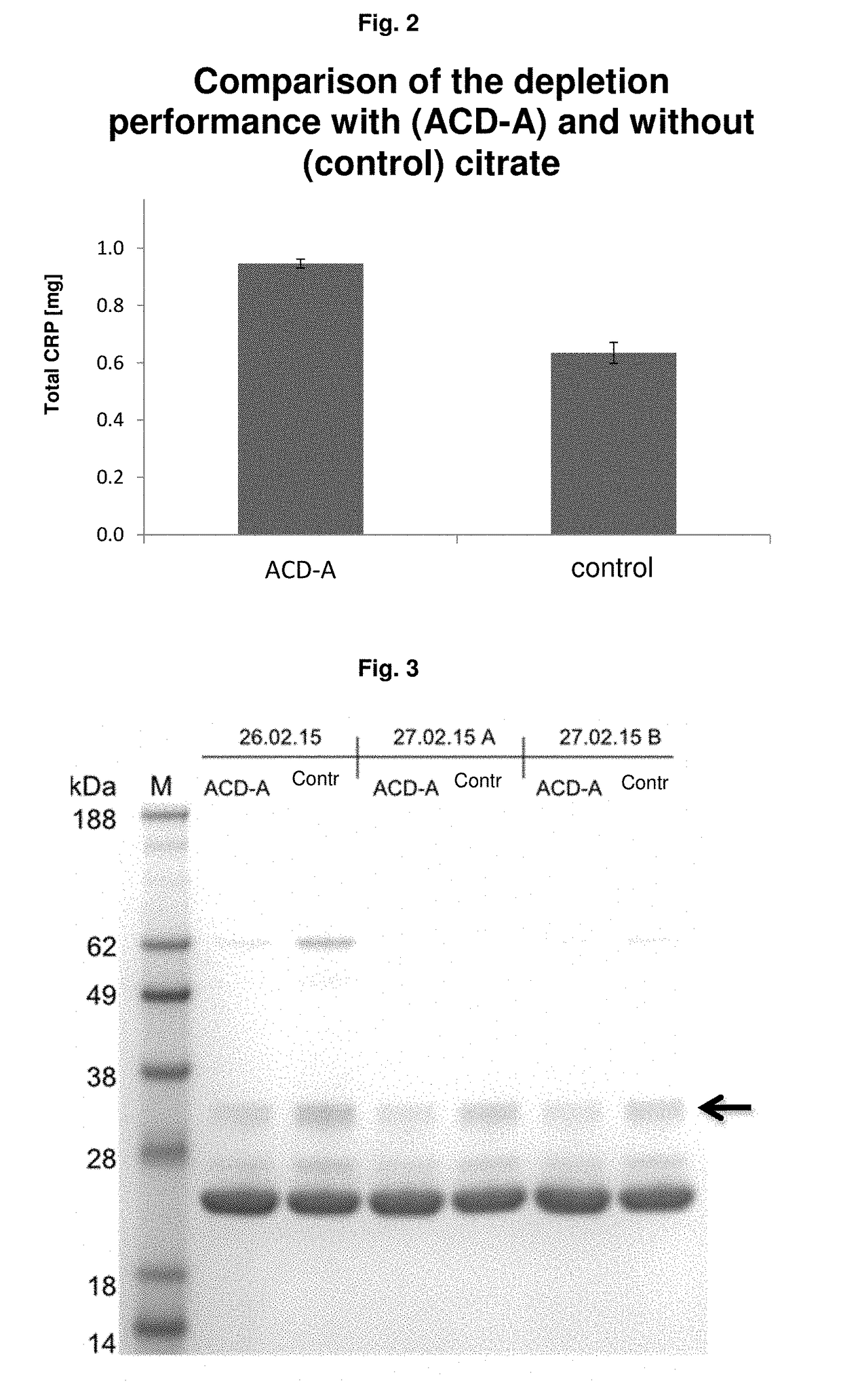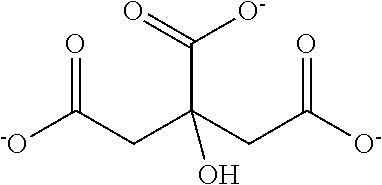Use of a citrate solution for affinity chromatographic purification of crp using phosphocholine and derivatives thereof
a technology of affinity chromatography and citrate solution, which is applied in the direction of c-reactive protein, peptide source, separation process, etc., can solve the problems common and most damaging, and high medical cost of national health systems and health insurance funds, and achieves no significant reduction of high crp level (up to 1000-fold above normal values)
- Summary
- Abstract
- Description
- Claims
- Application Information
AI Technical Summary
Benefits of technology
Problems solved by technology
Method used
Image
Examples
example 1
Comparative Study on the Effect of Addition of Citrate Solution on the Affinity-Chromatographic Purification of CRP from Blood Plasma
[0204]As a starting material, human blood plasma with a CRP concentration of approximately 50 mg / L was filtered using a 35 μm-filter, and optionally citrate solution was added (see below).
General Procedure of Affinity-Chromatography
[0205]For chromatography, a low-pressure chromatography system (BioLogic™ LP System, Bio-Rad, Munich Germany, catalogue number 731-8300), together with a column (Mobicol “Classic”, MoBiTec GmbH, Göttingen, Germany, product number M1002) with a 35 μm-filter (MoBiTec GmbH, product number M523515) was used, which was equipped with 0.5 g of APPC-coupled agarose (epoxy-Ultraflow-4 agarose, Sterogene) as column material (1.6 mg APPC / ml), i.e. a column material with a sepharose-matrix to which the phosphocholine derivative p-aminophenylphosphocholine (APPC) was coupled. The column was equilibrated with 3 matrix volumes (MV) wash bu...
example 2
hu-CRP ELISA for the Determination of the CRP Concentration in Samples
[0223]In order to determine the effectiveness of an affinity-chromatographic purification of CRP from biological fluids e.g. blood plasma, the concentration of human CRP (hu-CRP) in the appropriate samples were determined by means of an immunoassay (ELISA, Enzyme Linked Immunosorbent Assay).
[0224]To this end, the wells of a microtiter plate were first coated with an antibody directed against human CRP by adding 100 μI of a solution of rabbit polyclonal anti-human CRP antibody (Dako, Hamburg, Germany, product number Q0329), diluted 1:500 in coating buffer (0.1 M NaHCO3), incubated for 1 h at room temperature. It was then washed four times with at least 250 μI of PBST (0.1% Tween 20 in PBS).
[0225]For the determination of the concentration, sample buffer (5 mM EDTA in PBST) as a zero calibration and a standard series with concentrations of 300, 200, 100, 50, 30, 15 and 8.3 ng CRP / ml (in sample buffer) were used. For ...
example 3
CRP Depletion Under Citrate
[0232]A blood plasma with a defined CRP concentration (38.8 mg / l) was divided into 12.5 ml each. One half was diluted with the addition of citrate (acid-citrate-dextrose-solution A (ACD-A)-solution 1:15) over the affinity chromatography column (0.5 ml matrix volume of agarose coupled with 4-aminophenylphosphocholine), the other half was passed without ACD-A over an identical column. The CRP content was determined before and after apheresis. From this, the distant amount of CRP was calculated. It was found that after addition of citrate, more CRP binds to the column and is removed. The results are shown in FIG. 2
[0233]The eluates were also applied to an SDS gel, the photo of which is shown in FIG. 3. It is shown that in the apheresis with citrate (ACD-A) less complement (C1q) is removed than in apheresis without citrate solution.
[0234]The capacity increase of the column due to the citrate is explained by the present inventors, without claim to correctness, ...
PUM
| Property | Measurement | Unit |
|---|---|---|
| pH | aaaaa | aaaaa |
| pH | aaaaa | aaaaa |
| pH | aaaaa | aaaaa |
Abstract
Description
Claims
Application Information
 Login to View More
Login to View More - R&D
- Intellectual Property
- Life Sciences
- Materials
- Tech Scout
- Unparalleled Data Quality
- Higher Quality Content
- 60% Fewer Hallucinations
Browse by: Latest US Patents, China's latest patents, Technical Efficacy Thesaurus, Application Domain, Technology Topic, Popular Technical Reports.
© 2025 PatSnap. All rights reserved.Legal|Privacy policy|Modern Slavery Act Transparency Statement|Sitemap|About US| Contact US: help@patsnap.com



